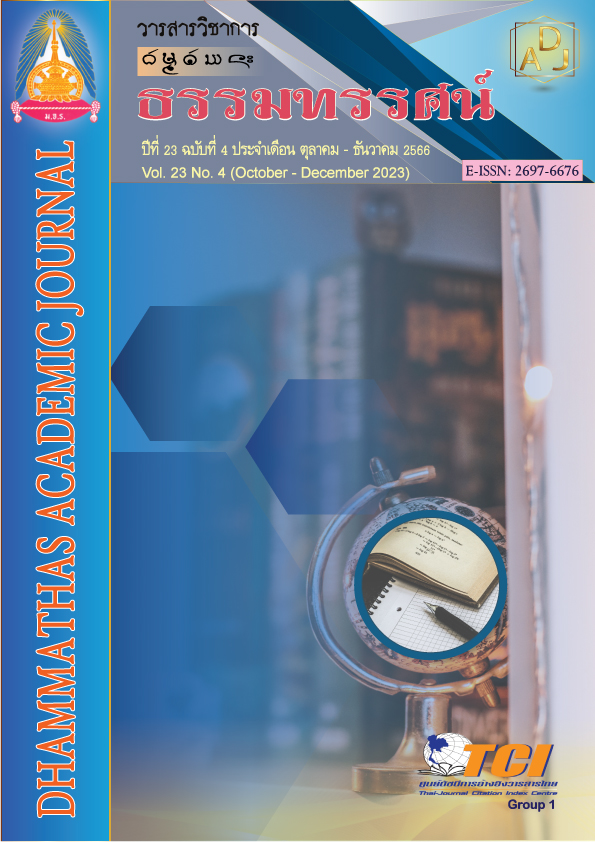The So Ethnic Group: Ways of Living, Sociocultural Characteristics and Changes
Main Article Content
Abstract
This research aimed to examine the so ethnic group's ways of living and sociocultural characteristics. It also investigated the social and cultural changes in the Isan society context. This qualitative research design focused on the process of fieldwork collected from the so ethnic group through observation, survey, and interviews. There were 74 key informants via purposive sampling. The data were analyzed via content analysis following the research objectives.
The findings showed that:
1. The So ethnic group belongs to the Austroasiatic language family, Mon-Khmer branch, or Katuic. Historically, the so ethnic group moved from Laos in the early Rattanakosin Period. In their traditional society, the so held ‘Heet Kong’ or a belief in ghosts in different ways. Such beliefs became behavioural models and relationships among people in the group. They had a unique way of life, language, beliefs, cultures and traditions where they became like an ethnic border from other ethnic groups, especially Lao/Isan people. They are often perceived as inferior to other ethnic groups by outsiders.
2. Currently, the so ethnic group is under the Thai state, they have integrated into the Thai nation through technology power, such as education, religion and bureaucracy. These cause social and cultural changes in various aspects, including modifying lifestyles and society following other people in the Isan community. Such practices of the ‘Heet Kong’ have been modified in order to conform with the local people in the Isan society.
Article Details

This work is licensed under a Creative Commons Attribution-NonCommercial-NoDerivatives 4.0 International License.
เพื่อให้เป็นไปตามกฎหมายลิขสิทธิ์ ผู้นิพนธ์ทุกท่านต้องลงลายมือชื่อในแบบฟอร์มใบมอบลิขสิทธิ์บทความ ให้แก่วารสารฯ พร้อมกับบทความต้นฉบับที่ได้แก้ไขครั้งสุดท้าย นอกจากนี้ ผู้นิพนธ์ทุกท่านต้องยืนยันว่าบทความ ต้นฉบับที่ส่งมาตีพิมพ์นั้น ได้ส่งมาตีพิมพ์เฉพาะในวารสาร วิชาการธรรม ทรรศน์ เพียงแห่งเดียวเท่านั้น หากมีการใช้ ภาพหรือตารางของผู้นิพนธ์อื่นที่ปรากฏในสิ่งตีพิมพ์อื่นมาแล้ว ผู้นิพนธ์ต้องขออนุญาตเจ้าของลิขสิทธิ์ก่อน พร้อมทั้ง แสดงหนังสือที่ได้รับการยินยอมต่อบรรณาธิการ ก่อนที่บทความจะได้รับการตีพิมพ์References
เกียรติศักดิ์ บังเพลิง. (2558). ชุมชนชาติพันธุ์ “บรู” ร่วมสมัยบนพื้นที่ชายแดนไทย-ลาว: วิถีชีวิตและการปรับตัวทางวัฒนธรรม. (ปริญญานิพนธ์ปรัชญาดุษฎีบัณฑิต). กรุงเทพฯ: มหาวิทยาลัยธรรมศาสตร์.
ขบวน พลตรี. (2527). การผสมกลมกลืนทางวัฒนธรรมของโซ่กับวัฒนธรรมภาคตะวันออกเฉียงเหนือ ศึกษากรณีตำบลกุสุมาลย์และตำบลโพธิ์ไพศาล อำเภอกุสุมาลย์ จังหวัดสกลนคร. (ปริญญานิพนธ์ศิลปศาสตรมหาบัณฑิต). กรุงเทพฯ: มหาวิทยาลัยเกษตรศาสตร์.
ทรงพันธ์ วรรณมาศ. (2521). วัฒนธรรมการแต่งกายดั้งเดิมในอีสาน. การสัมมนาประวัติศาสตร์อีสาน. มหาสารคาม: มหาวิทยาลัยศรีนครินทรวิโรฒ มหาสารคาม.
ธวัชชัย ไพใหล. (2562). กลุ่มชาติพันธุ์ไทโส้ในแอ่งสกลนคร. วารสารบัณฑิตศึกษา มหาวิทยาลัยราชภัฎสกลนคร, 16(74), 225-234.
ผจงจิตต์ อธิคมนันทะ. (2538). การเปลี่ยนแปลงทางสังคมและวัฒนธรรม. (พิมพ์ครั้งที่ 10). กรุงเทพฯ: มหาวิทยาลัยรามคำแหง.
ราชบัณฑิตยสถาน. (2525). พจนานุกรมฉบับราชบัณฑิตยสถาน พุทธศักราช 2525. กรุงเทพฯ: อักษรเจริญทัศน์.
สวัสดิ์ ดวงจันทร์ และคณะ. (2522). ประเพณีอีสาน. อุบลราชธานี: เขตการศึกษา 11.
สุเทพ สุนทรเภสัช. (2548). หมู่บ้านอีสานยุคสงครามเย็น: สังคมวิทยาของหมู่บ้านภาคตะวันออกเฉียงเหนือ. กรุงเทพฯ: งานดี.
สุภางค์ จันทวานิช. (2546). วิธีการวิจัยเชิงคุณภาพ. (พิมพ์ครั้งที่ 11). กรุงเทพฯ: จุฬาลงกรณ์มหาวิทยาลัย.
แสงเพชร สุพร. (2533). โลกทัศน์กลุ่มชาติพันธุ์โซ่: กรณีบ้านหนองยาง ตำบลชะโนดน้อย อำเภอดงหลวง จังหวัดมุกดาหาร. (ปริญญานิพนธ์ศิลปศาสตรมหาบัณฑิต). มหาสารคาม: มหาวิทยาลัยศรีนครินทรวิโรฒ มหาสารคาม.
อภิชาต ภัทรธรรม. (2558). ชาวไทโส้ หรือกะโส้. วารสารการจัดการป่าไม้, 9(1), 148-151.
Malesevic, S. (2010). Ethnicity in Time and space: A Conceptual Analysis. Critical Sociology, 37(1), 67-82.

